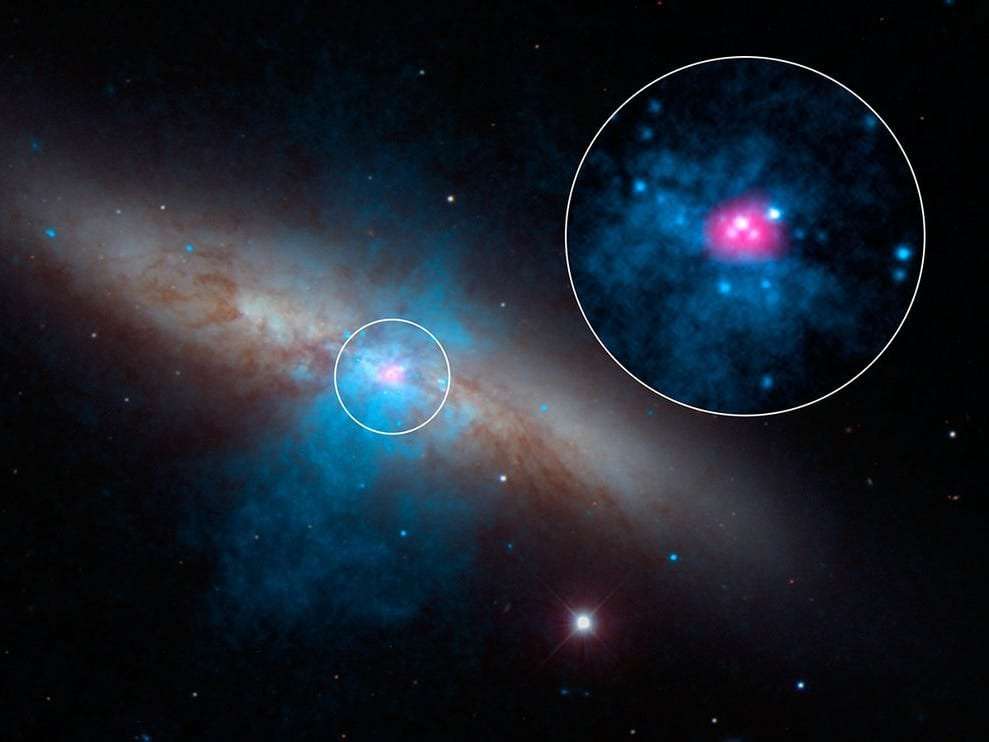Ultraluminous X-ray sources (ULX) are objects that shine ten million times brighter than the sun.
Scientists have said they are too bright to exist, as they break the so-called Eddington limit.
A new study confirms the brightness of a ULX — leaving the mystery of how it exists unsolved.
Scientists have been left baffled by a mysterious celestial object so bright that physics dictates it should have exploded.
NASA has been tracking so-called ultraluminous X-ray sources (ULX), impossible objects that can be 10 million times brighter than the sun, to understand how they work.
These objects are impossible in theory because they break the Eddington limit, a rule of astrophysics that dictates that an object can only be so bright before it breaks apart.
A new study categorically confirms that M82 X-2, a ULX 12 million light-years away, is as bright as previous observation suggested it to be.
But the question remains: how can it possibly exist?
Objects that are that luminous should push matter away
The principle behind Sir Arthur Eddington's rule is simple. Brightness on this scale only comes from material — like stardust of remnants of disintegrating planets — that falls inward toward a massive object, such as a black hole or a dead star.
As it is pulled by the object's intense gravity, the material heats up and radiates light. The more matter falls towards the object, the brighter it is. But there's a catch.
At a certain point, so much matter is being pulled in that the radiation it's emitting should be able to overwhelm the power of the gravity from the massive object. That means at some point, the radiation from the matter should push it away, and it should stop falling in.
But if it were not falling in, the matter shouldn't be radiating, which means the object shouldn't be that bright. Hence the Eddington limit.
M82 X-2 is achieving the impossible
Because of the Eddington limit, scientists have questioned whether a ULX's brightness was indeed caused by enormous amounts of material falling into it.
One theory, for instance, is that strong cosmic winds concentrated all the material into a cone. In this theory, the cone would be pointed toward the Earth, which would create a beam of light that would look much brighter to us than if the material was scattered evenly around the ULX.
But a new study looking at M82 X-2, a ULX caused by a pulsating neutron star in the Messier 82 galaxy, put the cone theory to rest.
The analysis, published in The Astrophysical Journal in April, found that M82 X-2 pulls in about 9 billion trillion tons of material per year from a neighboring star, or about 1.5 times the mass of Earth, per a NASA statement.
That means the brightness of this ULX is indeed caused by limit-breaking amounts of material.
Super strong magnetic fields may squish atoms into submission
Given this information, another explanation has become the leading theory to explain ULXs. And it is even more bizarre.
In this theory, super-strong magnetic fields shoot out of the neutron star. These would be so strong that they would squish the atoms of the matter falling into the star, turning the shape of these atoms from a sphere into an elongated string, per NASA's statement.
In this case, the radiation coming from these squished atoms would have a harder time pushing the matter away, explaining why so much matter could fall into the star without breaking apart.
The problem is that we'll never be able to test this theory on Earth. These theoretical magnetic fields would have to be so strong that no magnet on Earth could reproduce them.
"This is the beauty of astronomy. Observing the sky, we expand our ability to investigate how the universe works. On the other hand, we cannot really set up experiments to get quick answers," Matteo Bachetti, an author on the study and astrophysicist with the National Institute of Astrophysics' Cagliari Observatory, said in NASA's statement.
"We have to wait for the universe to show us its secrets," he said.
Read the original article on Business Insider

NihilusVoid on May 10th, 2023 at 18:53 UTC »
Maybe someone just pointed a laser at us.
zomboromcom on May 10th, 2023 at 18:53 UTC »
It's a Maquis plot.
autotldr on May 10th, 2023 at 18:44 UTC »
This is the best tl;dr I could make, original reduced by 88%. (I'm a bot)
Extended Summary | FAQ | Feedback | Top keywords: object#1 matter#2 material#3 bright#4 fall#5